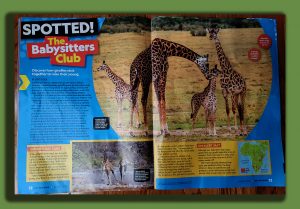Do you love giraffes? Take a look at the babysitters who watch the calves (baby giraffes) while the mom is away!
You know that some children have babysitters when the parents aren’t at home. The babysitters watch and protect the children. Do you know other baby animals that have babysitters of their own when the parents aren’t around? Baby giraffes, or calves!
Calves have to have a babysitter while their mother is having a break to eat. Why? Well, let’s look at this example provided by the article: “Curled up next to a fallen tree on the sunny African savanna, a napping baby giraffe opens its big brown eyes. Awakened by the sounds of an approaching animal, the five-week-old male straightens his coiled neck, scans the area, and freezes: Two lionesses are prowling nearby. Suddenly a 15-foot-tall female giraffe launches herself in between the baby and the lions. She places her Frisbee-size front hooves in front of the cats, and the pair slinks away.”
That is why calves need babysitters while the mother is away. Even if it’s only for five minutes. The baby might get devoured by two lions without a babysitter, and even though the two lions get a hearty meal, the mother would probably be depressed (or probably regret not getting a babysitter). Calves have to be protected by an elder giraffe, and that’s why they have babysitters.
The babysitters form a crèche, or a small group of a few adults and the calves. It helps the babies grow strong because they’ll conserve energy they need to grow quickly. Babysitters for human children might play games with you, but giraffe babysitters are all about gravity. Their fundamental job is to focus on keeping predators away and assure that none of the babies run off. This is easy for the babysitters because of their elevated view and keen eyesight to warn the herd in time via infrasonic communication. This is when giraffes make noises that are at a frequency too low for humans to hear. After the calves are tall enough and no longer easy prey, they can say goodbye to their babysitters for good.
This article also talks about how giraffes use their tongue for things other than eating. They use their tongue to grab leaves from trees, clean the insides of their ears-gross-retrieve ants that are trying to escape giraffes, and produce spit to protect themselves from the toxins in leaves. The article talks about four species of giraffes around the world, each with its own spot pattern.
First of all, the Masai giraffe lives in Kenya, Tanzania, and Zambia, and they have the darkest spots of all giraffes. Next, there is the reticulated giraffe, which lives in Ethiopia, Kenya, and Somalia. “Reticulated” means divided, just like the giraffe’s spots are. It has divided patches, and I believe it’s a very unique pattern. Then there are the Northern giraffes, which live in many countries across West, Central, and East Africa. They have few spots on their lower legs. Last but not least comes the Southern giraffe. They’re found in several countries across southern Africa. These giraffes have blotchy, star-shaped spots that expand all the way down their legs.
This is an article that’s full of information about babysitters for baby giraffes. I never knew about some of this info, like the cleaning of the ear with tongue part, or the Masai giraffe. It’s educational for kids and, while having information about a topic, is also quirky! In conclusion, this article would be perfect for giraffe lovers and those eager to learn about them!
Written by Kruti Patel


